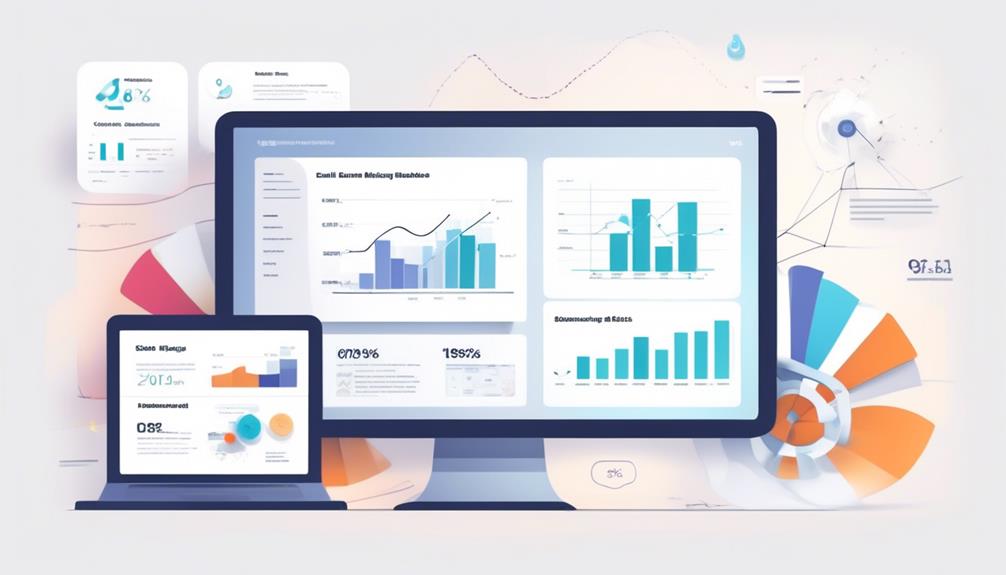By sheer coincidence, we stumbled upon the five crucial email deliverability tactics that all smart marketers should know about.
Ensuring that your emails actually reach your audience is crucial for any successful marketing campaign. Keeping up with email marketing trends and best practices is essential for maximizing the impact of your campaigns. From personalization and segmentation to mobile optimization and interactive content, staying current with the latest strategies can help you stand out in crowded inboxes. By understanding and adapting to these trends, you can increase the chances of your emails being opened, read, and converted into action by your target audience.
But what are these tips, and how can they benefit your email marketing strategy?
Let's uncover the key insights that can significantly impact your email deliverability and ultimately, the success of your marketing efforts.
Key Takeaways
- Implement email authentication methods such as SPF, DKIM, and DMARC to prevent email spoofing and verify the legitimacy of the sender.
- Establish a clear and transparent opt-in process for subscribers, including a double opt-in option for extra confirmation, to ensure compliance with data protection laws and clearly communicate the type and frequency of emails.
- Craft compelling and relevant email content, optimizing it for mobile devices, avoiding spam trigger words and excessive punctuation, and personalizing emails based on recipient preferences and behavior.
- Maintain a good sender reputation by authenticating emails, clearly marking them with a physical address, adhering to anti-spam laws, and regularly monitoring engagement metrics to adjust sending frequency and improve engagement rates.
Email Authentication
We implement SPF (Sender Policy Framework) to prevent email spoofing and ensure the integrity of our email communications. By using email authentication methods such as SPF, DKIM, and DMARC, we enhance the deliverability of our marketing emails.
These authentication protocols validate the legitimacy of the sender and help in reducing the risk of emails being marked as spam. Implementing SPF and DKIM allows us to add a digital signature to our emails, verifying that they're from a trusted source. By enabling DMARC, we protect our domain from unauthorized use and monitor email authentication processes.
Regularly monitoring and updating our authentication records is crucial for maintaining high email deliverability rates. Improving email deliverability enhances our brand's reputation and ensures that our emails reach the inbox every time.
It's essential to focus on email authentication as one of the best practices to improve our email deliverability and maintain a low spam score. This helps in building trust with mailbox providers and increasing the chances of our emails being delivered to the recipient's inbox.
Opt-In Process

After implementing SPF and DKIM to enhance email authentication, the next crucial step is to establish a clear and transparent opt-in process for subscribers to explicitly consent to receiving emails. This process is essential for maintaining a healthy and engaged email list and improving email deliverability.
Offering a double opt-in option, where subscribers confirm their subscription via a confirmation email, provides an extra layer of confirmation and helps ensure that the provided email addresses are valid and owned by the subscribers. It's important to clearly communicate the type and frequency of emails subscribers will receive upon opting in.
Additionally, the opt-in process should comply with relevant data protection laws, such as GDPR, by providing necessary information and options for consent. Regularly reviewing and updating the opt-in process is crucial to avoid falling into spam traps and being marked as a spam email by recipients.
Email Content
Crafting compelling and relevant email content is essential for improving deliverability rates and engaging subscribers effectively. To enhance email deliverability, it's crucial to avoid spam trigger words and excessive punctuation in the email content.
Additionally, optimizing email design for mobile devices is essential as a large portion of recipients access emails on their mobile devices. Clear and concise subject lines can significantly improve open rates and ultimately, deliverability.
Personalizing emails based on recipient preferences and behavior can also enhance engagement and deliverability. It's important to note that the sender's reputation, including the sender score and domain reputation, also plays a crucial role in email deliverability.
Using an email testing tool to analyze the email content before sending it can help identify potential issues that might trigger spam filters. Furthermore, ensuring that the recipient's email address is valid and up to date is essential for successful inbox placement.
Sender Reputation

Enhancing deliverability by maintaining a positive sender reputation is crucial for ensuring that email content reaches recipients' inboxes and avoids being filtered as spam. To achieve this, smart marketers must adhere to deliverability best practices and take proactive steps to safeguard their sender reputation. Here are some essential strategies for managing sender reputation effectively:
| Best Practices | Description |
|---|---|
| Authenticate your email | Implement authentication protocols such as SPF, DKIM, and DMARC to protect sender domains and enhance deliverability. |
| Mark your emails | Clearly mark your emails with your physical address to comply with anti-spam laws and build trust with recipients. |
| Dedicated IP address | Consider using a dedicated IP address for your email program to maintain a distinct sender reputation and avoid potential issues. |
Cadence and Engagement
Tailoring the frequency and content of email sends to match recipient engagement patterns is essential for optimizing email cadence and fostering higher engagement rates. When considering cadence and engagement in email marketing, here are three key strategies to keep in mind:
- Regular Monitoring: Regularly monitor and analyze engagement metrics such as open rates and click-through rates to optimize your email cadence. This involves keeping a close eye on subscriber behavior and adjusting the sending frequency based on their interactions with your emails.
- Utilize Automation: Utilize email automation to send timely and relevant messages based on subscriber behavior and preferences. Automation allows for personalized and targeted communication, which can significantly improve engagement rates.
- Find the Right Balance: Finding the right balance between sending frequency and valuable content is crucial for maintaining high email engagement. It's important to strike a balance that keeps your audience engaged without overwhelming them with excessive emails.
Frequently Asked Questions
What Are the Key Ways to Improve Email Deliverability in Email Marketing?
Improving email deliverability involves using authentication protocols like SPF, DKIM, and DMARC to protect our domain.
We monitor and manage email bounces, distinguishing between soft and hard bounces, and handle them appropriately.
We also reduce spam complaints by obtaining explicit consent, honoring unsubscribe requests, and sending targeted, relevant content.
Additionally, we optimize email content and formatting, personalize, optimize for mobile, and continuously monitor key metrics to refine our email marketing strategy.
What Is the Average Email Deliverability Rate for Marketers?
The average email deliverability rate for marketers is typically around 85% to 90%. We've observed this rate to be influenced by factors like sender reputation, email content, and infrastructure.
It's crucial to monitor and improve deliverability through authentication protocols, bounce management, spam complaint reduction, and optimizing email content.
We've found that maintaining high deliverability rates is essential for maximizing ROI, enhancing customer engagement, and establishing trust with recipients.
How Do I Get Email Deliverability?
To improve email deliverability, we take the following steps:
- Authenticate emails with SPF, DKIM, and DMARC.
- Monitor bounce rates to distinguish between soft and hard bounces and take action accordingly.
- Provide clear opt-in options and segment our list to avoid spam complaints.
- Avoid spam triggers in our email content.
- Optimize content by personalizing emails, optimizing for mobile, and keeping the content relevant.
- Continuously monitor key metrics and refine our strategy based on data-driven insights.
How Do You Monitor and Maintain High Deliverability Rates for Your Email Campaigns?
We monitor and maintain high email deliverability rates by:
- Regularly analyzing bounce rates
- Implementing SPF, DKIM, and DMARC protocols for email authentication
- Utilizing dedicated IP addresses
- Reducing spam complaints through clear opt-in options and targeted content
- Testing different sending frequencies
By doing so, we ensure that our email campaigns reach the intended recipients and maintain a positive sender reputation.
This proactive approach helps us optimize our email deliverability for maximum impact.
What Are the Best Email Deliverability Tips for Marketers to Improve Their Campaigns?
When it comes to enhancing email deliverability, marketers should prioritize maintaining a clean and engaged email list. Implementing double opt-ins can also help ensure that recipients are genuinely interested in receiving emails, ultimately improving open rates and reducing the risk of being marked as spam. Email deliverability tips marketers.
Conclusion
In conclusion, following these top 5 email deliverability tips can significantly improve your email marketing success.
For example, a company saw a 20% increase in open rates and a 15% decrease in bounce rates after implementing email authentication and optimizing their sender reputation.
By staying proactive and implementing these strategies, smart marketers can maintain high deliverability rates and reach their target audience effectively.









